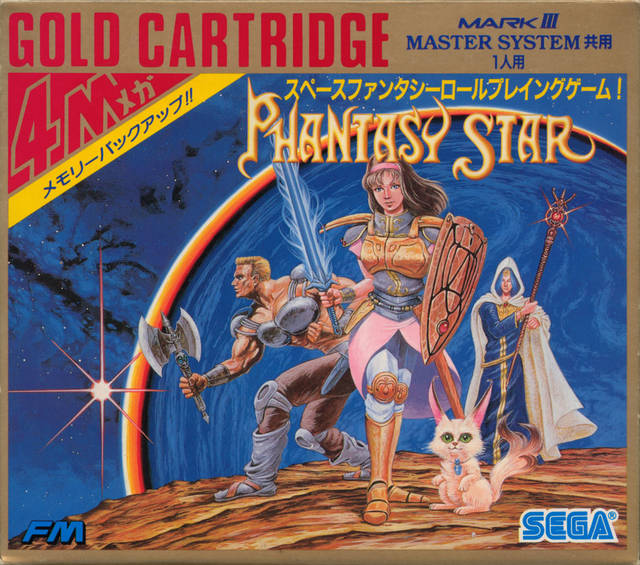
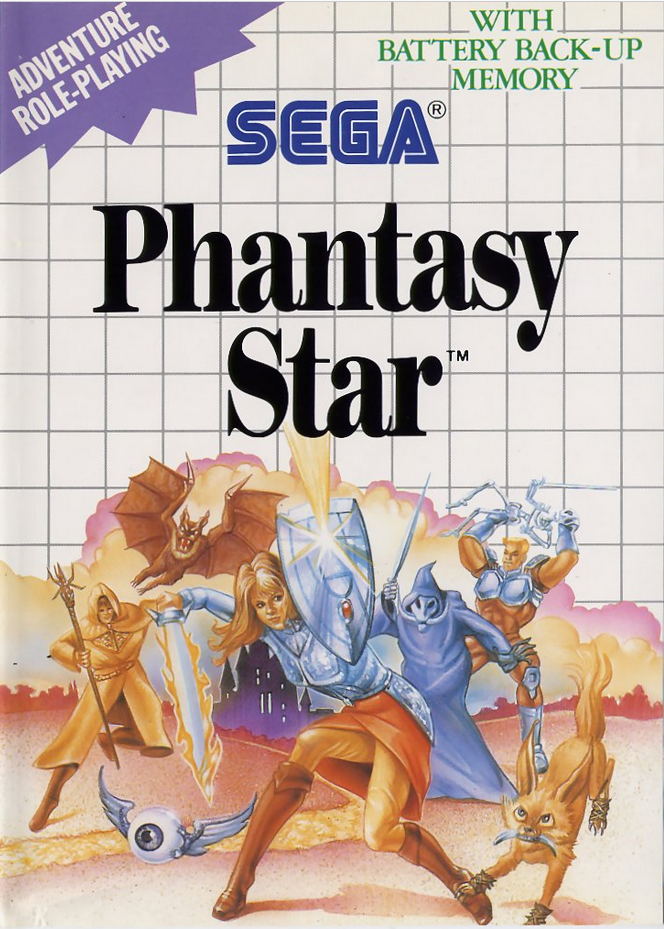
PLAYERS: 1
PUBLISHER/DEVELOPER: Sega
GENRE: RPG
RELEASE DATE: 12/20/87 – (JP), 11/88 – (US), 1988 – (EU)
Phantasy Star is, to paraphrase Snoop Dogg, the gangsta ish. In an era before kids even knew what role-playing-games were, Phantasy Star brought them out back and showed them what it was like. Not just with its staggering $69.99 price tag (which amounts to about $140 in today’s money), but with the interplanetary traveling, first-person pseudo-3D dungeon exploration, and extensive length and difficulty. A role-playing-game Phantasy Star certainly was and is, but for Master System owners hungry for a break from arcade ports, it was their first real adventure. One that would linger for a lifetime.
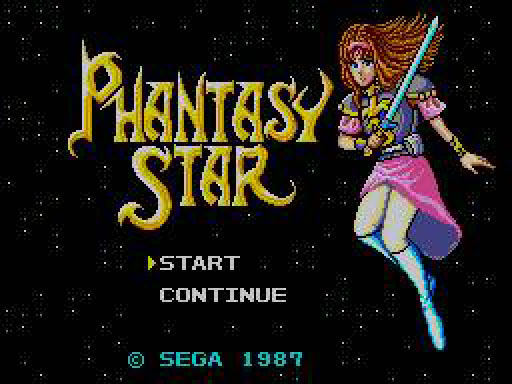
Phantasy Star begins with a death scene. Nero Landale, a leader of a rebellion against the evil King Lassic, is shot down by Lassic’s robocops. Alis, Nero’s sister and the main protagonist of the game, holds him in his final moments, then promises revenge on Lassic for his death.
This wasn’t just an average death scene given through text. This was a cutscene. A straight-up cutscene in 1988. The first cutscene in any console game in the West? I won’t make that claim, but it’s certainly one of the first. Ninja Gaiden on the NES was praised for its dynamic cutscenes, and rightfully so, but it wasn’t released until 1989 (December ’88 in Japan, for all you date sticklers out there). With these jarring cinematic intros showcasing at least two of the game’s four megs of power, the $70 pricetag had already justified itself.
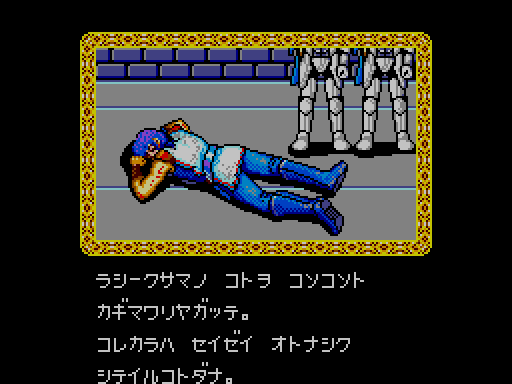
Alis begins her adventure on the planet Palma, in the town of Camineet. From there, she can talk to the townsfolk, buy weapons, armor, and food, and get herself healed up, if need be. The townsfolk have lots of cryptic, socially awkward things to say – things that you should nevertheless write down because they’re actually clues. Once Alis leaves Camineet, she’s free to explore the landscape of Palma and get into battles. Lots of battles. So many battles, your eyes will bleed. Yes, if you want to get anywhere in Phantasy Star, you’ll have to indulge in that harsh, discordant activity, grinding. Experience doesn’t come for free, and neither do Mesetas, the game’s currency system. In order to get the best weapons (the Laconian Axe, the Laser Gun, the Light Saber) and the best items that make life easier down the road (the Magic Lamp, the Crystal, the Hovercraft), you’ll need to search every cave, tower, desert, mountain, beach, and forest.
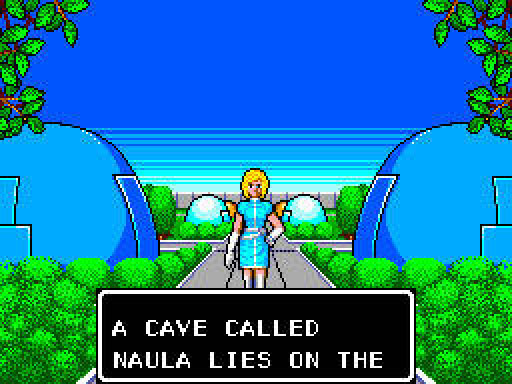
Along the way, you’ll team up with Odin the Warrior, Myau the Alien Cat, and Noah the Sorcerer. Odin is the team’s resident meat-eater, beer-drinker, axe-slinger. Hard-drinkin’, hard-livin’, but he always shows up to work on time. And in the end, one of his best weapons is the none-too-sissy Laser Gun. Fancy that! Myau might be adorable, but she’ll use all of her nine lives to prove how deadly she is. She’s got decent scratching abilities and she’s the resident healer of the ground. Truly a cat of all trades. Noah, bless him, is the weakling of the group in terms of attack power. But his white robe makes a cool swishing noise, and his magician status allows him to cast some strong spells.
This is your crew, and it’s no exaggeration to say that you’ll grow attached to all of them as you play. Considering that there’s very little character development, I was impressed with how much I appreciated each character. You bond through the understood silence of warriors and through the constant battling. Each character has their strengths and weaknesses which you discover as you travel and fight. The warriors hardly utter a word, yet you realize that you need each other, and the player is all the richer for this unspoken dynamic.
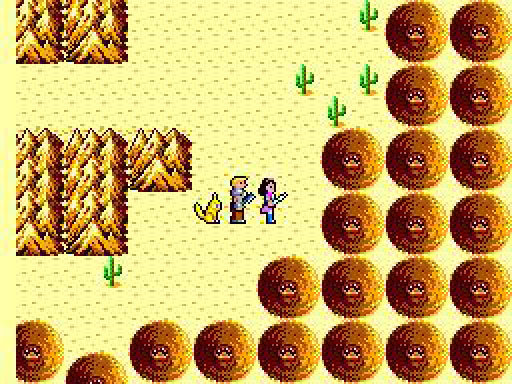
There’s two types of exploration in this game: top-down overworld, where you guide your party members from a viewpoint in the sky, and first-person dungeon exploration. The former will be familiar to most retro RPG aficionados. Your party wanders around the overworld looking for areas to explore and is periodically interrupted (every other step) by battles. Once you enter a cave or a tower, the game’s perspective will shift to first-person. While graphically breathtaking in their day, the dungeons of this game are brutal to explore. Even in some of the earlier dungeons, you’ll need to use graph paper to keep track of where you’re going and where you’ve been. Thankfully, if you get stuck, there are items like the Flute and the Exit spell that will help you get to safety.
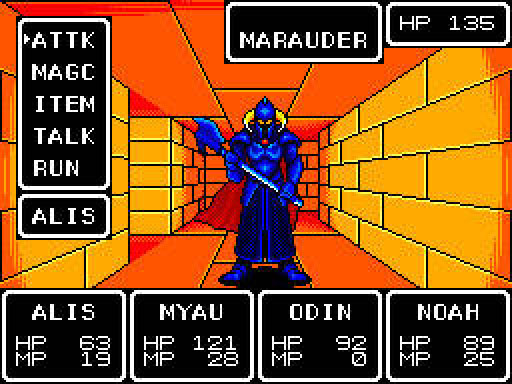
As the team gets stronger and progresses the story, you eventually travel to two other planets: Motavia, a desert planet, and Dezoris, an ice world. You don’t just walk there, though. You fly. In a rocket ship. Driven by a robot. Indeed, seeing the ship blast across the galaxy is a gamechanger. This brief travel scene shows you how ambitious Phantasy Star is. Traversing across one planet is fine and good for most games, but three planets? Even though you are fairly limited as to where you can go, the game tricks you into thinking the planets are larger than they are. At different points during the game, you’ll acquire vehicles to better explore the areas: Hovercraft, Landrover, and an Ice Digger. All of these vehicles will help you travel across treacherous terrain with ease. The Ice Digger is particularly cool, as it can burrow through layers of ice on Dezoris, revealing hidden caves and secrets and such. Features like the latter help the worlds to feel like well-crafted alien planets. Their hostile terrain is unkind to your party, but they provide rich rewards for those willing to explore.
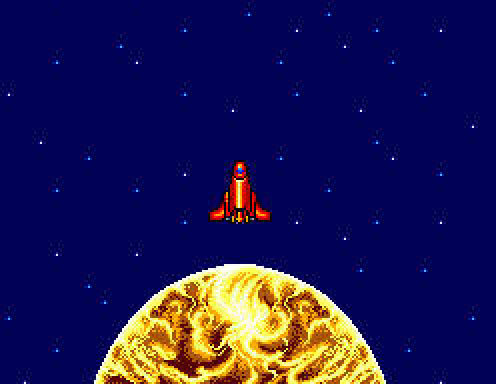
Once a battle begins, the monster appears in front of you, a menu box appears to the upper left, and the character’s health and magic stats appear in boxes underneath the screen. The menu gives you the options to Attack, use Items, Magic, Run, and even Talk to the monsters (just a heads up, this rarely works). Once you choose an option, the game cycles through each person and monster until either the monster dies or the party members die. Treasure chests are always gained from beating a monster, and while monsters are always good for Mesetas, there are also traps hidden in chests. Be careful, as the type of trap could kill you if your health is low enough.
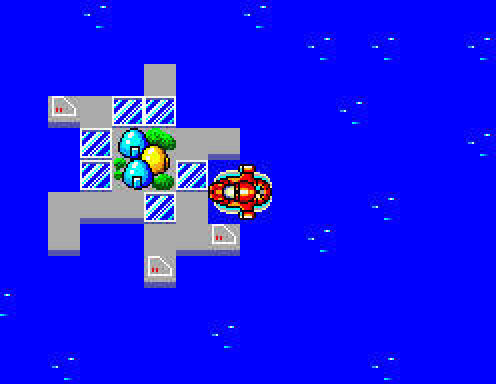
If the last couple paragraphs sound more or less like every Japanese RPG you’ve ever played from approximately 1988 to 2002-ish, that’s because Phantasy Star was a template for all those role-playing-games you’ve enjoyed over the years. Dragon Quest certainly streamlined RPGs for the mainstream in Japan, but Phantasy Star solidified turn-based battles as the system to use, established the party system (four characters, even), the importance of an in-depth story with characters you care about, and exploring out-of-the-way secret locations for items. Sure, Final Fantasy expanded on these elements. Lots of RPGs did. The reason the genre became as popular as it did was because fans not only knew what to expect, they wanted more of the same in slightly different trappings. Phantasy Star – without meaning to, I’d wager – started several RPG tropes that linger until this day.
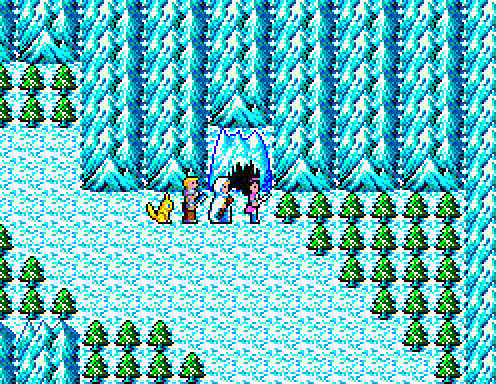
Special mention needs to be made to the fantastic monster designs and animations. The first time I saw a zombie lower his jaw and excrete vomit, I was in awe. Every enemy has their own special attack animation and look that gives them personality. Later enemy designs, like the Centaur, the Troll, and the various colored Dragons are incredibly well-rendered and intimidating as all hell.

If I had to level a complaint at Phantasy Star‘s way, it would be the game’s soul-rending difficulty, particularly in the later temples. Graph paper will only get you so far with some of them, due to the plentiful doorways and traps, all leading to God knows where. Figuring out where the dungeon drops you wouldn’t be so hard, though, if you weren’t up against an unholy amount of enemies at the same time. They’ll destroy you if you don’t have the best weapons and equipment in the game, and even then, you’ll take a solid thrashing.
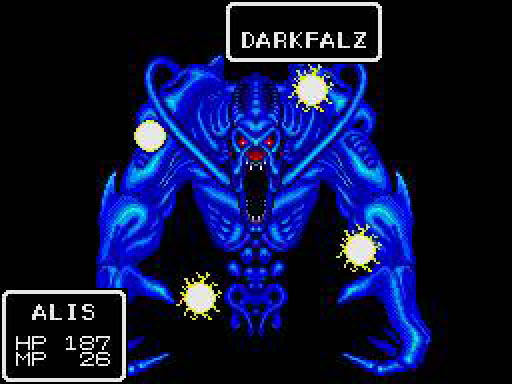
To really understand Phantasy Star‘s impact, you have to realize that there was no other game like it at the time. Miracle Warriors – the first RPG Sega (regrettably) released for the Master System – didn’t even come close to Phantasy Star‘s scope nor did it play as smoothly. Dragon Quest had released a year prior to Phantasy Star in Japan, but in the West, Dragon Warrior didn’t emerge until 1989, several months after the former. Final Fantasy was a whole year away. Thus, Phantasy Star had a significant period in which it made NES-owning children jealous of those who owned Master Systems. After a couple years of NESheads rubbing the fantastic Zelda and Metroid in Master System owner’s faces, the beleaguered console lovers had a game to call their own. Alex Kidd in Miracle World might have been Sega’s flagship title for the Master System, the pony/monkey that they bet all their arcade tokens on, but Phantasy Star is the console’s crowning achievement.
A-
*images generously provided by GameFAQs.
^image generously provided by VGMuseum.com


24 replies on “Phantasy Star (Master System, 1987)”
“Sure, Final Fantasy expanded on these elements.”
The problem for Sega (in regards to making inroads on Nintendo’s lead in the market) is that the original Final Fantasy came out within days of Phantasy Star in Japan. Still, the original Phantasy Star is a triumph for the Master System.
D’oh on Sega’s part. Sometimes they had the worst luck.
That’s an understatement. Also released within the same six day period: two little known games called Mega Man and Metal Gear (the Famicom/NES version at any rate).
The same week I believe. I for one always stand on the side that Phantasy Star is the better game than FF. But they are both really good. But Sega got this game out over here way , way before FF. Like when FF came out here, the Genesis was already out and Phantasy Star 2 had been released already for 3 months already.
Nintendo took wayyyyy too long to bring games over from Japan.
It was the RPGs that they had the worst problems bringing over. FDS conversions like the Zeldas and the first two Castlevanias seemed to be locked in at a year, and other games were largely determined by content/translation issues, but the RPG situation was bad. Of course, they had to essentially open the US branches of Enix and then Square, too, so that probably explains why it took three years for Dragon Quest/Warrior to show up (the major graphical overhaul and the save system added in didn’t help matters, I suspect).
I believe there was a real question whether Nintendo thought that Japanse RPGS could succeed in America. If you ever look at the top reviewed and selling games for the Famicom, they were all RPG.s. Americas market for the NES was essentially action games. There was a real fear that they would not be worth the time and effort to translate. The first RPG on the NES , Dragon Warrior, Nintendo resorted to giving away with subscriptions to Nintendo Power. Sega had essentially nothing to lose and quickly brought out RPGS to own that market for quite awile. Nintendo wouldn’t really regain the reputation for the place to play RPG’s till the Super Nintendo where they did not make the same mistake twice, and released a flood of some of the greatest RPGS of all time pretty much to decimate the Genesis offerings that had been released so far. There were a few standouts on the Genesis like Lunar on the Sega CD and of course Phatasy Star IV. And Sega did just fine holding its own with SRPGs like Shinong Force. But the SNES body of work was hard to beat making it the JRPG system in the 16-bit era.
Yay! After a bunch of middling titles finally a top game. The Master System doesn’t have that many duffers, but it doesn’t have that many great titles either.
This was one of the first JRPG’s I played (fairly recently in the MegaDrive collection). I enjoyed it, but did require the use of a FAQ on occasion.
Yes, an FAQ is very important for this game.
Yes!! Phantasy Star! I will always hold this game in very high regard. It took nearly the entire summer, and I remember trying to beat it and then I spent the remainder of the year wishing for a sequel to come out in pretty immediate fashion. I previously commented in the Miracle Warriors talk that after beating Miracle Warriors I got Phantasy Star and completely forgot about Miracle Warriors. Phantasy Star was incredible. Each time you got a new spell specific to a character or a new vehicle or made it to the next planet it was EPIC! I think Sega of Americas campaign for “Sega Does…” could have started with Phantasy Star IF more people knew just what a JRPG was at the time. Another great thing about Phantasy Star was the box art, as you mentioned. While not as mythical as the Mark III’s box, it does show they didn’t just put a shopkeeper and a hamburger on the cover and leave it at that. I actually like the Western version box art for a change. It doesn’t beat the Japanese one (wonder why they took gaming so serious with release date masses of Dragon Quests and here in the States poor Sean had to call the stores weekly to find out if Miracle Warriors was out). Great review, Dylan. You earned your mesetas on this one.
Thanks, Sam. Yeah, I was surprised by the Western cover, as well. Sega of America couldn’t phone this one in, and they knew it.
Oh, and I remember having to label my graph paper pages of the certain dungeons when they got entirely too big. That was an OCD I never knew I would have.
Do you still have any? If so, I’m requesting pics.
I wrote a whole lot about this but it got deleted before I could hit publish. So I’ve had a few hours to think about it and condense my thoughts a little. First off, this game is so good I question the -. In my case why not even a +. This is not only my favorite SMS game,its my favorite 8-bit game period. Maybe one of my top ten games of all time. I like this game better than II and III. Talking about its few faults first, compared to what would come later, the combat is a little basic. Sure there were lots of weapons to spice combat up. And there is some minimal strategy in beating enemies more efficiently by deciding Attack order etc. But the combat is a little basic. The difficulty is on par with other 8-bit RPGS. I used tons of graph paper mapping put the dungeons. A necessity when on late game 9 floor dungeons multiple traps. But I appreciated spending a few months with this game.mi enjoy a good challenge and the payoff for sticking with it was always worth it. The game didn’t have the party building mechanics of say FF where you say choose two red mages , a fighter and white Mage. But on the plus side it allowed for actual character to your characters. Your fighters had personality and back story’s.
As far as why I love this game. It just never stopped amazing me from start to finish. Amazing cutscenes that were absolutely uncommon at the time. Great music. I can still remember exiting the battle theme and hearing the main overworld theme slowly fade back in as if exiting from a bad dream. Another thing not touched upon is the melding of sci-Fi and fantasy. You explored a world of fantasy monsters along side laser guns and stellar travel to different alien worlds on a spaceship.absolutely one of the first game series to meld scifi and fantasy. Drop dead georgeous graphics. This game looks better than a lot of 16-bit games. With backrounds for every different environment, amazing detailed and animated battles. Me and my friends would just find Zomies and undead to fight to watch the amazing Attack animation. Screen filling bosses. Not just one but three different vehicles tha all had different abilitys. Four if you count the spaceship. All kinds of interesting characters like the mad scientist who would kill Myau if you didn’t answer his questions properly. The first or one of the first instance of an unbeatable boss battle in a game that you could not win that foreshadowed things to come. The amazing moment of Myaus transformation with the Laerna nut that you was thing topped by a screen filling battle with a dragon on the way to Lassics floating castle. One of the first total surprise fakepout final boss battles when you avenge your brothers death only to return to governor for what you think is the ending but fight the true ultimate evil. (BTW the Dark Falz is a misspelling, it’s is actualy Dark Force. Another name change that was important and confusing was Lutz was renamed Noah in the US, which is confusing when Lutz makes an appearance in number 2. It is actually Noah from the first game.) Dark Force would reappear throughout the series, but the surprise element was the best in the first game. Only to be outdone in IV by taking players expectations about him and bring it to ridiculous levels outrageousness to surprise players expectations. One of the great endings in an 8-bit game rather than just a roll of credits.
Needless to say this game made a huge impression on me. I don’t remember a game looking this good at the time on the NES or the PC for that matter. When I sold it later through a newspaper classified ad, I remember this guy drove like 80 miles to buy it off of me for 60.00. This was the game I used to show the superiority of the SMS. To me this is the one game that stands above all other 8-bit games for me at the time. It is just about perfect. And really kindled my passion for RPG’s I. The early years. (Which I don’t really have anymore.) whether you like this or FF more is a matter of personal opinion. They are both great games. There are a few things FF does better. But not much. In any case this is an essential game for anyone interested in 8-bit RPG’s.
Thanks for your thoughts, Sean. I appreciate your perspective because you played it when it first emerged. To be honest, I’m surprised I enjoyed it as much as I did, nearly 30 years after its release. That just goes to show you how great the game is. Sega pulled out all the stops with this one.
Sean, to this day this is THE 8-bit game in my collection (well, I did keep Parlor Games and the 3D segascope games too, but…) and it still has a few different saved games on it. You hit on some interesting stuff in your comment. I believe if it weren’t for Phantasy Star 1, fans of Sega Master System would be a different breed of gamers as a whole. If Phantasy Star wasn’t as enthralling I might have never took as much interest in JRPGs. I know after comparing PS to FF1 I had a chip on my shoulder about NES gamers who thought Dragon Warrior and FF games were the cat’s meow. A friend of mine who has a save file on my original Phantasy Star cart told me he’d never played something that you could drink a beer, smoke a cigarette and swear casually while playing. In his mind, this is the type of interactive story he’d been waiting for and couldn’t get enough of. I agreed then. I had often hoped the next Phantasy Star would have been more to do with Alis and Myau. Hell, it is kind of late for the series to go that far back now, but I am all for it. Good mention about the sci-fi and fantasy. It held my interests for that and many reasons.
I’d also like to note Sega continues to make great female protagonists so early in videogame history. This may be the first time I’d played a femal protagonist in a video game, and certainly the first RPG with one that I know of. (Remember the Ninja changed its hero to a man in the US. We never saw Girls Garden And Ms. Pacman doesn’t count.)
Not only that, it’s a female character that is not played for sex appeal. Alis is fully and sensibly clothed throughout and a strong female character. Really quite groundbreaking at the time. I’m noticing somewhat of a trend with Sega on this. I wonder how much of it had to do with the influence of Reiko Kodama at Sega? This is an actual retro Videogame that Anita Sarkeesian might find no fault with.
Don’t speak so soon, Sean RE: Anita, though I wouldn’t mind hearing her thoughts on this.
And you’re right, Sega was pretty ahead of the curve (no pun intended) with their female protagonists.
Hi Dylan,
Great Review as always! I played and completed this game for the first time about 2 years ago (an exact port on the gameboy advance). I’ve beated its sequel (again on the gba) only 2 months ago. I must sadly state, that I was greatly underwhelmed by that last game. The 8-bit SMS-game is graphically more impressive (environments, enemy designs) and I also like it’s story better.
You said the following:
“If I had to level a complaint at Phantasy Star‘s way, it would be the game’s soul-rending difficulty”
I usually find rpg’s to be the easiest games on 8- and 16- bit consoles
these games, unlike most other games of the time, usually have a save-feature (or others like Y’s at least a password-feature). This means you never have to worry about losing all your progress. I for instance find a platformer ala Super Mario Bros that is considered to be a fairly easy game,way more difficult. Playing the first few – I’ll admit simple levels – for the umpthied time, scavenging for 1ups, to see all your hard earned tries squandered in a near impossible jump in world 8 or a moment of hammer-madness really demands perseverance!
Sure levelling-up, grinding or mapping can get rather boring/tedious in these old-school rpg’s But they are not persé difficult
The adventuring elements (where to go next? use what item on who?) are the thoughest in these type of games. But I found PS to be on the less obscure site of RPG’s in this regard. Definitly nothing that comes close to a Zelda-puzzle
Anyways keep up the good work!
That’s a good point-of-view, Pieter. I’ve never had much trouble with platformers, but I’ve often forgotten to save in RPGs like Phantasy Star. Of course, this is MY fault, not the game’s fault, and losing a save doesn’t make the game harder per say. Still, I do believe that the last third of Phantasy Star really ratchets up the challenge.
Man speaking of saving I have to share just one more story about this game. So you can literally save anywhere. So I had saved in the middle of that 9 level dungeon woth all the traps and I pushed too far and got a whole bunch of levels and loot. And I almost got wiped out at the bottom. I saved then realized I had no healing items or magic and only two of my party were alive with like 10 HP. I literally had to walk a few steps and save all the way out of that dungeon from the bottom. If I hit a random encounter I completely died and had to reload. I spent like an hour taking 3 steps and saving to get out. All the way back to town. I made sure to always have an escape pipe after that, and not save so often. That really sucked.
I love how many comments this has, one more won’t hurt
You should try this one Sam. I have been told this one of the few games you can drink a beer, smoke a cigarette and draw maps on graph paper without losing your head.
Yeah, those first person dungeons really ramp up the difficulty toward the end. Still, when I played this through to the end a few years ago I was surprised to realise how close I’d come to finishing it on a weekend rental as a kid. Great game; I think it’s my favourite of the series and my favourite 8-bit console-only RPG.